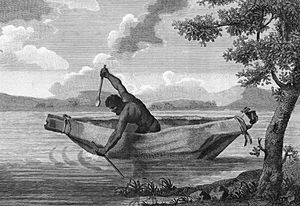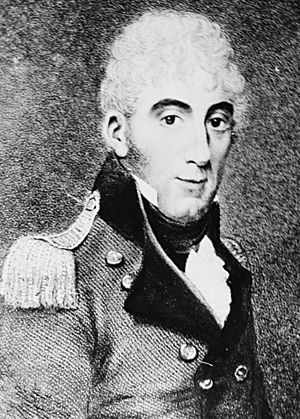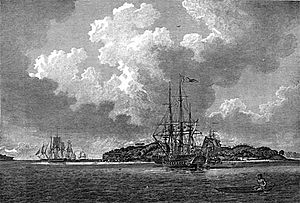John Caesar facts for kids
Quick facts for kids
John Caesar
|
|
|---|---|
| Born | c. 1763 |
| Died | 15 February 1796 (aged 32–33) Liberty Plains, Colony of New South Wales, Australia
|
| Other names | Black Caesar |
| Children | Mary Anne Fisher Power |
| Conviction(s) | Sent to Australia for stealing (1786) Sentence extended for stealing food (1789) |
| Criminal penalty | Sentenced for 7 years Sentence extended for life |
John Caesar (born around 1763, died February 15, 1796), also known as Black Caesar, was one of the first people from the African continent to arrive in Australia. He is famous for being Australia's first bushranger, a person who lived in the wild and survived outside the law.
Born in Madagascar, Caesar was taken to the United States as an enslaved person. He later made his way to England, where he was arrested for stealing. As punishment, he was sent to the new British colony in Australia with the First Fleet in 1788. Life in the colony was very hard, and Caesar often escaped into the bush to survive. Because of his many escapes, he became a legendary figure.
Contents
A Long Journey to Australia
John Caesar was born around 1763, likely in Madagascar. His birth name is not known. As a young man, he was taken to America and forced into slavery in Virginia or South Carolina. It was common for enslaved people to be given names like Caesar, and he was probably named by his owner.
By 1786, Caesar was living as a servant in England. He may have escaped to the British side during the American Revolutionary War to gain his freedom. It's also possible his owner was a Loyalist who moved back to England after the war.
Sent to a New Colony
In 1786, Caesar was charged with stealing money from a house in Kent, England. At that time, Britain dealt with some crimes through penal transportation. This meant that instead of going to a local prison, convicts were sent to a faraway penal colony. Caesar was sentenced to seven years in the colony of New South Wales.
On January 6, 1787, he boarded the convict ship Alexander. This ship was part of the First Fleet, the group of ships that brought the first European settlers and convicts to Australia.
Life in the New South Wales Colony
The Alexander arrived at Botany Bay on January 19, 1788. Caesar was sent to work on Garden Island, which was a tough place to live. He became known as "Black Caesar" and was respected as a very hard worker.
Life for convicts was difficult, and they often did not have enough to eat. The weekly food allowance was very small, and Caesar, who was tall and muscular, was always hungry. This led him to steal food. In April 1789, he was caught stealing and his sentence was changed from seven years to life in the colony.
Australia's First Bushranger
Just two weeks after his new sentence, Caesar escaped into the bush. He took some food, a pot, and a musket with him. A British officer, David Collins, called him "an incorrigibly stubborn black."
Caesar was very clever at surviving in the wild. He would steal food from the colony or from local Aboriginal people. After he was caught, Collins noted that Caesar was not afraid of being punished. He was sent back to work on Garden Island, this time in chains.
On December 22, 1789, Caesar escaped again. He struggled to find food after losing his musket and was speared by local Aboriginal people. He returned to the colony and surrendered. He was sent to a hospital to recover from his injuries.
Life on Norfolk Island
Instead of punishing him further, Governor Arthur Phillip pardoned Caesar. In March 1790, he was sent to Norfolk Island, another island settlement. There, he was given some independence and a small plot of land to farm.
On Norfolk Island, Caesar had a child with an English convict named Anne Power. Their daughter, Mary Anne, was born in 1792. A year later, Caesar returned to the main colony at Port Jackson, leaving his family behind.
Encounter with Pemulwuy

During the 1790s, a brave Bidjigal warrior named Pemulwuy led attacks against the British settlers to defend his people's land. In late 1795, Pemulwuy and his warriors attacked a work party that Caesar was part of.
In the fight, Caesar managed to crack Pemulwuy's skull, seriously wounding him. The colonists thought Pemulwuy was dead, and Caesar was praised by the colonial leaders for his actions.
Final Escape and Legacy
In December 1795, Caesar escaped for the last time. He led a small group of other escaped convicts, and they raided settlements around Port Jackson. The colonists were warned not to help him.
On January 29, 1796, Governor John Hunter offered a large reward for Caesar's capture. A man named John Wimbow tracked Caesar to an area called Liberty Plains (now the suburb of Strathfield). Wimbow ambushed Caesar and shot him. Caesar was taken to a nearby hut, where he died a few hours later on February 15, 1796.
Why John Caesar is Remembered

John Caesar is considered Australia's first bushranger. Bushrangers play a big part in Australia's national story, with figures like Ned Kelly being very famous. However, the fact that the very first bushranger was a Black man from Africa is a part of history that was often forgotten.
Historians believe Caesar's story was overlooked because it didn't fit the popular image of Australian heroes. His amazing life journey, which took him across four continents—Africa, North America, Europe, and Australia—shows how connected the world was, even in the 18th century.
His daughter, Mary Anne, was adopted after her mother died. She later moved to Van Diemen's Land (now Tasmania) in 1814.
See also
- List of convicts transported to Australia
- African Australians


